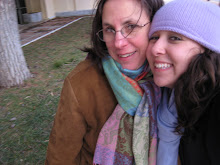A bead piece where you "needle weave" the first and last row. In this case you simply employ the tradtional methodo f bead "weaving" to start and finish the piece. In other words with threads all flat (this applies whether you are or are not using the shedding device) put your strung beads behind and in between the warps (if you are using the shedding device, it is in the neutral position and you are treating each pair of threads as one thread) and sew through the beads on the top of the warp. The next row can either continue this way, if you are NOT using the shedding device, or, if you are using the shedding device, by raising and lowering half the threads in order to actually weave your beads in between the two layers of threads. You will end your piece by again using the the traditional method of bead weaving.
A bead piece where you have woven a "header." This is actual weaving where you take your needle and thread and bring it under and over the warp threads, back and forth until you've built up about a half inch header. You can end your piece by creating a "footer,": same thing but at the end. For bead pieces begun and ended this way using the shedding device this will keep the piece from falling apart when you take it off the loom.
In all cases, you will need to tie off your warp ends after removing your piece]from the loom. I use overhand knots because other knots do not require tension to remain in place.
Claudia
Comments from Mary Alexander:
(Note from Claudia: This is an alternative way to begin and end a bead weaving which in fact is the same method one would use to begin and end a tapestry. It creates to fiber sections at the beginning and end of the weaving which you can fold under the bead weaving and sew to the back. It's a fast way to finish a bead piece.)
I weave a header before starting to weave the piece. I do this for one or both of two reasons. First, to get the warp threads to behave properly and to be sure they are in the right sequence. Secondly, if I also want to get rid of the warp threads after weaving. I also weave a "footer" after I've finished the bead weaving.
* in any case I use a yarn, or crochet thread, or whatever heavy bead thread I have available. I've been known to use micro-macrame cord. For discussion purposes I'll call this "yarn."
* I weave this just as we were taught in first grade ... tie on the yarn. then under / over / under /over etc .. one warp thread at a time across the first row, then reverse the sequence for the second row so that you are going OVER every warp thread that you had just gone under for the first row.
* I pack this yarn fairly tight as I weave it. I intend eventually to tie off all my warps by tying adjacent warps to each other.
* glueing the warp knots w/ Fray check or whatever works with the type of warp thread you are using.
* clipping the warps close to the knots,
* then folding the yarn header / footer over the knotted warps twice to encase the knots
* and sewing this yarn header/footer to the underside of the loom work.
the larger Mirrix looms have the option of using a shedding device. if the loom is to be warped for use with a shedding device, TWO warp threads are used in each spring dent. when the yarn headerand footer are woven, these two warp threads per dent are treated as one. When the first row of beads is woven with the shedding device
set up, these two warp threads are treated as one.
In essence, working with the shedding device creates a V shape, where half the warps are forward and the other half are back. The weft thread w/ all its beads is lain carefully into the base of this V and every bead is nestled gently into its proper place in between its two warp threads. Then you reverse the shed. The two sets of warp threads change places. The warps that had been in front of the weft thread w/ its beads now move to the back and close over the weft thread with all the beads, holding the beads in place.
Subscribe to:
Post Comments (Atom)


thank you! I have created and ruined 3 bracelets using loom beading. They were so beautiful but I could NOT figure out how to end them and add a bracelet closure. Your help is excellent and you allowed me to print it so I can continue to refer back. thanks again. PS I have been working with glass beads for 25 years and finally decided to try bead loom work and love it!!!
ReplyDelete